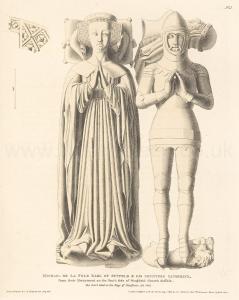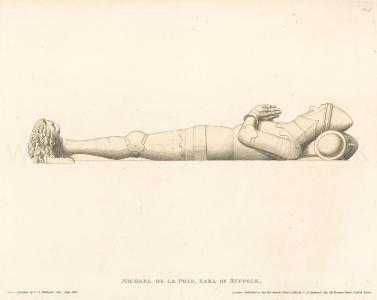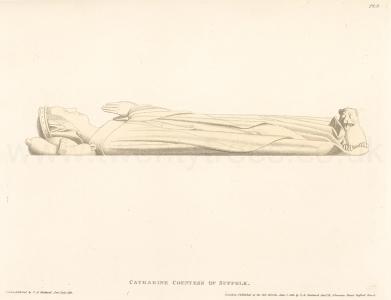Effigy of Michael de la Pole, Earl of Suffolk and his Countess Catherine
Effigy of Michael de la Pole, Earl of Suffolk and his Countess Catherine is in Monumental Effigies of Great Britain.
MICHAEL DE LA POLE, Earl of Suffolk, was the grandson of that eminent merchant of Hull, Sir William de la Pole, who was advanced to a Knight's and Banneret's degree for his servicesa to Edward the Third in the way of financial supplies. Michael de la Pole, his father, died at Paris in 1388, a fugitive from his country, having forfeited, by a decree of Parliament, his lands. About 1391 he married Catherine, daughter of Hugh Earl of Stafford, obtained a small pension from the Crown to aid his impoverished condition, the consequence of his father's impeachment, and had licence to travel abroad, where he probably watched the political changes for an opportunity to return; for in the first year of Henry the Fourth we find him petitioning for restoration of the lord-ships granted to his father as Earl of Suffolk. This petition, in consideration of the good services rendered to Henry of Bolingbroke on his landing in Yorkshire, was favourably received, and the demesne lands of his family, with the title of Earl of Suffolk, restored to him and his heirs.

In 1415 he was engaged to serve Henry the Fifth in his expedition into France. He was entrusted with the command of the rear-guarda of the English army, and was at the siege of Harfleur, with which operation the King opened the campaign. The Earl of Suffolk fell a victim at that place to the dysentery, which infected the English army. His son Michael, who was with him, succeeded to his honours, and within a month after the death of his father was slain on the glorious field of Azincourt. The Earl of Suffolk by his last will directed that his body should be buried near his father and mother, at the church of the Carthusians in Hull, if he should die in the north of England; if elsewhere, at Wingfield [Map] in the county of Suffolk, in the collegiate church of that placeb, on the north side of the altar of the blessed Virgin. To Catherine (age 40) his wife he gave a little book, with tablets of silver gilt, and the coronet which was the Earl of Stafford her father's. To his son a little primer, which belonged to John de la Pole, his brother.

He was buried at Wingfield, and the Countess his wife, who was one of his executors, erected, in all probability, the monument there which commemorates him and herself. The effigies of de la Pole and his Countess are eminently beautiful specimens of female and military costume in the time of Henry the Fifth. The grand simplicity of the very plain suit of plate-armour which he wears, personihes the idea which we entertain of the appearance of the martial spectre so boldly imagined by Shakspeare for one of his finest dramas.
Details. Plate 1. Ornamented fret of the Duchess's coiffure.
Note a. This appears to be an exception to the custom of conferring the degree of Banneret only on the held of battle, and for military services. See Dugdale's Baronage, vol. 1. p. 181.
Note b. The patronage of the Chantry at Wingfield came to his father, the first Earl of Suffolk, by marriage with Catherine, daughter of Sir John de Wingfield, who was his mother.
Note c. Stow, 4to. edit, black letter, p. 556.


